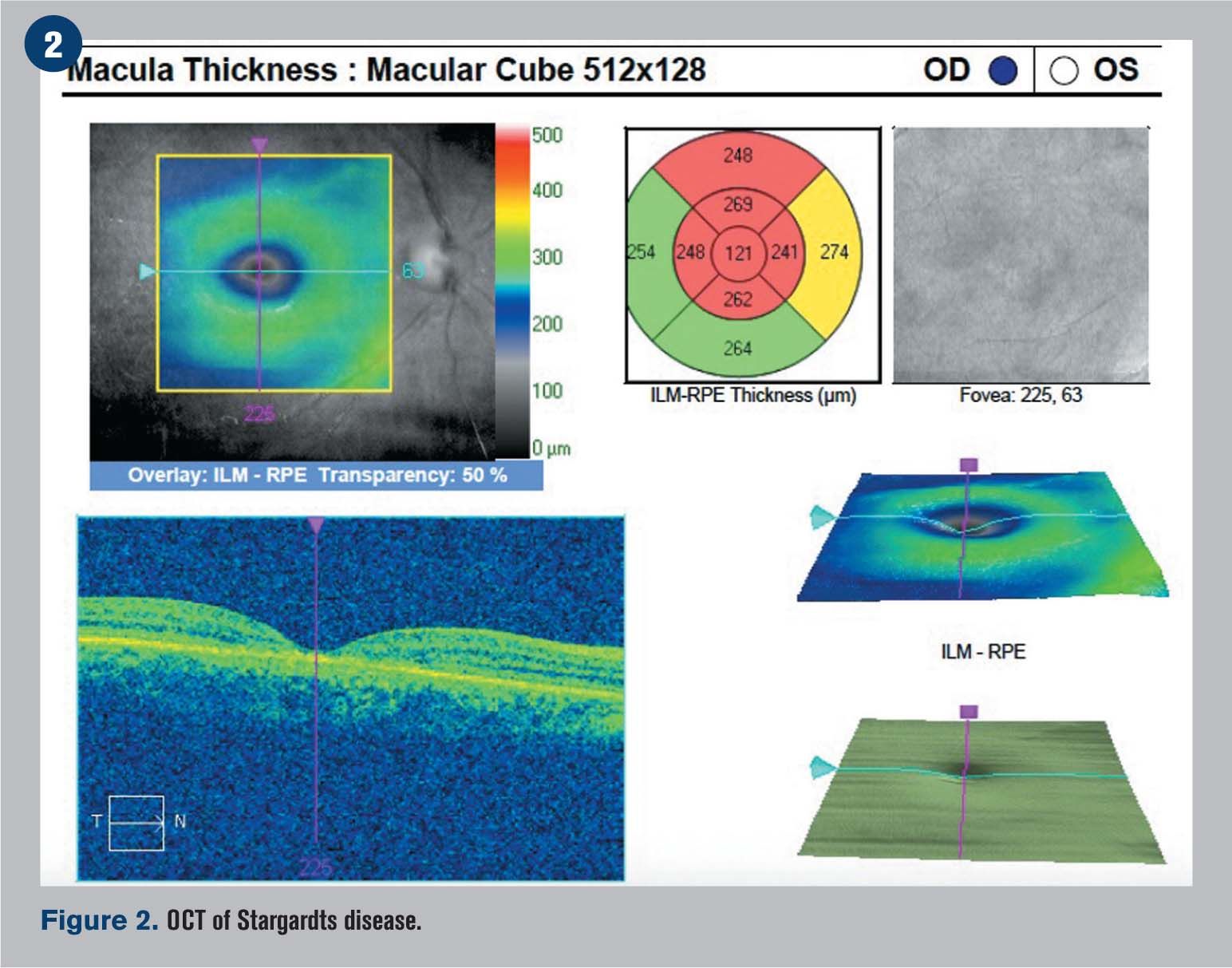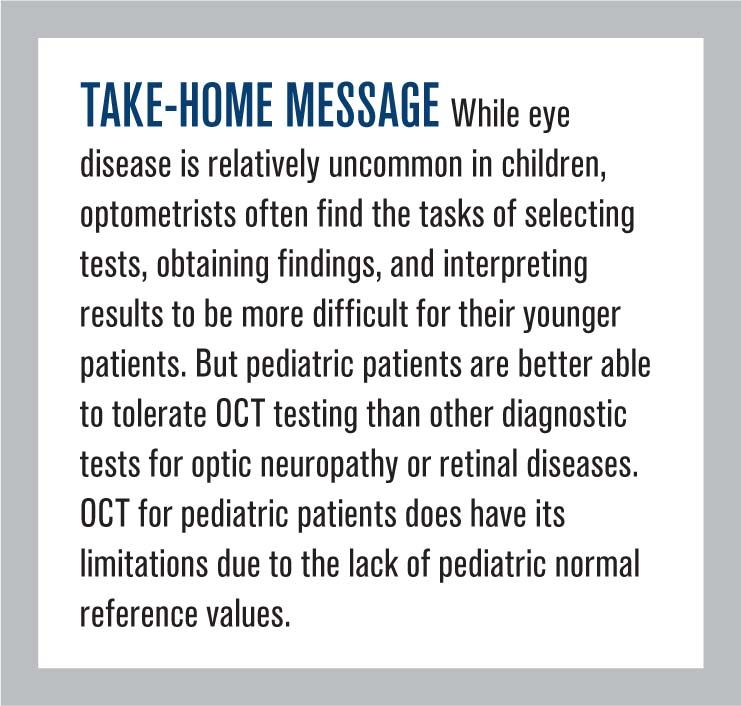OCT in pediatric eye disease
Eye disease is relatively uncommon in children. When it is present, however, optometrists may find the tasks of selecting tests, obtaining findings, and interpreting results to be more difficult.


Eye disease is relatively uncommon in children. When it is present, however, optometrists may find the tasks of selecting tests, obtaining findings, and interpreting results to be more difficult. Children are often moving targets. They quickly begin to fatigue or resist testing.
The optometrist may be more dependent on objective tests, due to limitations in obtaining a complete or detailed history. Young pediatric patients frequently cannot describe their symptoms, and the parent who accompanies them to their eye examination may or may not be present as the symptoms unfolded.
The potential of optical coherence tomography (OCT) to support diagnosis and management of pediatric ocular disease is particularly intriguing. OCT provides the optometrist with the ability to make microscopic retinal abnormalities clearly evident and to quantify and replicate measures of tissue structure.
Patients are better able to tolerate OCT testing than other diagnostic tests-OCT is not invasive and does not require a probe contact or use of an immersion medium.1 OCT also does not require radiation exposure, which may be a particular concern in the pediatric population.2
OCT creates high-quality cross-section images of tissue structure using interferometry.1 OCT originally developed in its time domain form that uses a time comparison with a moving reference arm to determine the depth of retinal tissue.3
Stratus OCT was designed as a time domain OCT. More recently, spectral domain OCT was developed. Spectral OCT assesses the interferometric signal as a function of optical frequencies.3 This enables a much faster scanning speed and density of scanning while reducing artifacts from eye motion.
This combination of increased speed with fewer artifacts from eye movements is particularly advantageous when working with pediatric patients.3 Clinicians and researchers have reported the use of OCT in children as a diagnostic tool, a tool to monitor treatment outcomes, and to investigate normal ocular tissue structure.
Related: How ACA can improve pediatric eye care
Diagnostic advantages of OCT
Diagnostically, OCT may be helpful to supplement visual field information or to provide information when visual field findings are not available. Visual field testing is commonly used to evaluate the visual system and to diagnose and monitor pathology.
To obtain reliable visual field results, however, the patient needs to understand the test, sustain attention, and respond accurately. Research suggests that children under the age of eight years old are not reliable visual field test takers.4
Next: OCT in optic neuropathy
OCT in optic neuropathy
For children suspected of having optic nerve pathology conditions such as glaucoma, optic nerve head (ONH) drusen, and optic neuropathy, OCT can help in diagnosis and monitoring treatment outcomes. In pediatric glaucoma cases, Spectral Domain SD-OCT has been shown to produce reproducible measurements of pediatric retinal nerve fiber layer (RNFL) and macular thickness.5
This makes it a useful tool in for diagnosing pediatric glaucoma as well as monitoring structural changes in glaucoma progression. In addition to these applications, OCT also may shed light on mechanisms of disease. In the condition of pediatric glaucoma, OCT has been used to study the phenomenon of cupping reversal.
Findings of one retrospective study suggest that in some cases, even when intraocular pressure (IOP) is lowered and ONH cupping reverses, RNFL continued to thin postoperatively.6
Ophthalmology Times: Swept-source OCT affords greater detailing in vitreous imaging
In non-glaucomatous optic neuropathy, SD-OCT has been used to diagnose and monitor pediatric patients. When SD-OCT is combined with eye tracking technology, it can obtain reproducible RNFL measurements, even in patients with decreased vision. 7 In optic disc elevation, OCT can be helpful in completing a careful assessment. Optic disc elevation can be caused by serious and progressive conditions such as optic nerve edema or benign, stable conditions such as ONH drusen.
Traditionally, B-scan ultrasonography has been the tool of choice in diagnosing ONH drusen. More recently, OCT has been used to evaluate patients with an elevated ONH to differentiate between optic disc edema and ONH drusen.2,9 In patients with ONH drusen, OCT can also be used to monitor any changes in RNFL thickness that may be associated with the condition.
OCT may also be useful in evaluating tilted disc syndrome.10 This condition can cause visual field defects. OCT can confirm a structural change that corresponds with measured field defects.
Next: Pediatric retinal conditions

Pediatric retinal conditions
In addition to its use in optic neuropathy, OCT is helpful in the diagnosis and monitoring of pediatric retinal conditions. Examining the retinae, particularly the maculae, of children can be particularly difficult. Detecting and documenting subtle changes in macular structure may be difficult or impossible in the fundus evaluation.
In a variety of retinal pathologies, pediatric patients may present with decreased visual acuity and subtle retinal findings. OCT has been used in the diagnosis of oculocutaneous albinism, epiretinal membranes, foveal hypoplasia, foveal retinoschisis, and Stargardt disease.10-14
Related: Examining pediatric eyes
OCT can enable the determination of a definitive diagnosis more quickly and lead to earlier treatment and better visual outcomes. In epiretinal membranes, OCT has shown significant differences between the pediatric condition and its adult counterpart.
In addition to diagnostic uses, OCT also has helped to manage outcomes. OCT has proven useful in predicting the surgical outcome of epiretinal membranes removal.12
In retinopathy of prematurity, OCT has proven useful in young patients receiving laser treatment. Macular edema is an associated complication, and SD-OCT can be used to detect subtle macular changes that may occur.15
Next: OCT limitations
OCT limitations
A limitation of OCT has been the lack of pediatric normal reference values. Work has begun, however, to report findings in specific pediatric populations,16,17 such as reference values of RNFL thickness in Chinese children and teenagers.18
Reports using Stratus OCT-3 (Carl Zeiss Meditec) suggest that macular volume, foveal thickness, and RNFL thickness may vary by race and age in pediatric populations.19
In fact, OCT may prove useful in expanding our understanding of normal ocular structure characteristics and how they differ in children from adults and among different subgroups of patients. For example, several studies have found that myopic children had significantly thinner macular thickness and smaller macular volumes.19, 20

OCT also may be useful in understanding functional limitations in patients who present with residual amblyopia or traumatic brain injury.
Preliminary findings have suggested that OCT may be helpful in localizing the cause of complaints associated with traumatic brain injury such as blurred vision, increased light sensitivity, double vision, visual field loss or reduction, and difficulties with eye movements.
In some cases, these symptoms may due to photoreceptor injury and not due to damage in the optic nerve or visual cortex..21
In amblyopia, both time-domain and spectral-domain OCT have been used to investigate macular volume and retinal thickness in amblyopic and non-amblyopic eyes.22-27 Many but not all of these reports have found differences in macular structure, retinal layer thickness, and RNFL.
Though more investigation is needed, OCT may help optometrists in the future to determine if decreased visual acuity is linked to structural differences and if the maximal visual acuity has been obtained in treating an amblyopic eye.
Diagnosing and managing pediatric eye disease is not always easy. OCT is a promising tool that provides objective data quickly and is non-invasive. In evaluating suspicious optic nerves and maculae in children, optometrists should consider OCT as a primary or supplemental test.
As pediatric normal reference values become available and additional studies are reported, its use in the pediatric population is likely to increase in the future.
References:
1. Costa RA, Skaf M, Melo LA, et al. Retinal assessment using optical coherence tomography. Prog Retin Eye Res. 2006 May;25(3):325-53.
2. Shah A, Szirth B, Sheng I, et al. Optic Disc Drusen in a child: Diagnosis using noninvasive imaging tools. Optom Vis Sci. 2013 Oct;90(10):269-73.
3. Forte R, Cennamo GL, Finelli ML, et al. Comparison of Time Domain Stratus OCT and Spectral Domain SLO/OCT for assessment of macular thickness and volume. Eye (Lond). 2009 Nov;23(11):2071-8.
4. Akar Y, Yimaz A, Yucel I. Assessment of an effective visual field testing strategy for a normal pediatric population. Ophthalmologica. 2008;222(5):329-33.
5. Ghasia F, El-Dairi M, Freedman S, et al. Reproducibility of Spectral-Domain Optical Coherence Tomography measurements in adult and pediatric glaucoma. J Glaucoma. 2015 Jan;24(1):55-63.
6. Ely A, El-Dairi M, Freedman S. Cupping Reversal in Pediatric Glaucoma-Evaluation of the Retinal Nerve Fiber Layer and Visual Field. Am J Ophthalmol. 2014 Nov;158(5):905-15.
7. Rajjoub R, Trimboli-Heidler C, Packer R, et al. Reproducibility of retinal nerve fiber layer thickness measures using eye tracking in children with nonglaucomatous optic neuropathy. Am J Ophthalmol. 2015 Jan;159(1):71-7.
8. Lee K, Woo S, Hwang J. Differentiation of optic nerve head drusen and optic disc edema with Spectral-Domain optical coherence tomography. Ophthalmology. 2011 May;118(5):971-7.
9. Pichi, F, Romano S, Villani E, et al. Spectral-domain optical coherence tomography findings in pediatric tilted disc syndrome. Graefes Arch Clin Exp Ophthalmol. 2014 Oct;252(10):1661-7.
10. Wilk M, McAllister J, Cooper R, et al. Relationship between foveal cone specialization and pit morphology in albinism. Invest Ophthalmol Vis Sci. 2014 May;55(7):4186-98.
11. Sisk R, Leng T. Multimodal imaging and multifocal electroretinography demonstrate autosomal recessive Stargardt Disease may present like occult macular dystrophy. Retina. 2014 Aug;34(8):1567-75.
12. Rothman A, Folgar F, Tong A, et al. Spectral domain OCT characterization of pediatric epiretinal membranes. Retina. 2014 Jul;34(7):1323-34.
13. Karaca EE, Cubuk MO, Ekici F, et al. Isolated foveal hypoplasia: Clinical presentation and imaging findings. Optom Vis Sci. 2014 Apr;91(4 Suppl 1):S61-5.
14. Kyung SE, Lee M. Foveal retinoschisis misdiagnosed as bilateral amblyopia. Int Ophthalmol. 2012 Dec;32(6);595-8.
15. Narang S, Singh A, Jain S, et al. Optical coherence tomography of fovea before and after laser treatment in retinopathy of prematurity. Middle East Afr J Ophthalmol. 2014 Oct-Dec;21(4):302-6.
16. Al-Haddad C, Barikian A, Jaroudi M, et al. Spectral domain optical coherence tomography in children: normative data and biometric correlations. BMC Ophthalmology. 2014 Apr 22;14:53.
17. El-Dairi MA, Asrani SG, Enyedi LB, et al. Optical coherence tomography in the eyes of normal children. Arch Ophthalmol. 2009 Jan;127(1):50-8.
18. Qian J, Wang W, Zhang X, et al. Optical Coherence Tomography measurements of Retinal Nerve Fiber Layer Thickness in Chinese Children and Teenagers. J Glaucoma. 2011 Oct;20(8):509-13.
19. Lim HT, Chun BY. Comparison of OCT Measurements between high myopic and low myopic children. Optom Vis Sci. 2013 Dec;90(12):1473-8.
20. Luo HD, Gazzard G, Fong A, et al. Myopia, axial length, and OCT characteristics of the macula in Singaporean children. Invest Ophthalmol Vis Sci. 2006 Jul;47(7):2773-81.
21. Flatter JA, Cooper RF, Dubow MJ, et al. Ocular retinal structure after closed-globe blunt ocular trauma. Retina. 2014 Oct0;34(10):2133-46.
22. Silva F, Alves S, Pina S, et al. Comparison of macular thickness and volume in amblyopic children using time domain optical coherence tomography. Oftalologica. 2012;36:231-6.
23. Agrawal S, Singh V, Singhal V. Cross-sectional study of macular thickness variations in unilateral amblyopia. J Clin Ophthalmol Res. 2014;2:15-7.
24. Szigeti A, Tatrai E, Szamosi A, et al. A morphological study of retinal changes in unilateral amblyopia using optical coherence tomography image segmentation. PLoS ONE. 2014 Feb 6;9(2): e88363.
25. Miki A, Shirakashi M, Yaoeda K, et al. Retinal nerve fiber layer thickness in recovered amblyopia. Clin Ophthalmol. 2010 Sep 20;4:1061-4.
26. Al Haddad E, Mollayess GM, Mahfoud ZR, et al. Macular ultrastructural features in amblyopia using high-definition optical coherence tomography. Br J Ophthalmol. 2013 Mar;97(3):318-22.
27. Yen MY, Cheng CY, Wang AG. Retinal nerve fiber layer thickness in unilateral amblyopia. Invest Ophthalmol Vis Sci. 2004 Jul;45(7):2224-30.
Newsletter
Want more insights like this? Subscribe to Optometry Times and get clinical pearls and practice tips delivered straight to your inbox.